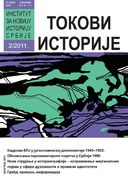Аутомобилом на југоисток - aутомобили као средство немачког продора у Краљевину Југославију
By Car to the South-East - the Automobile as the Means of German Penetration into the Kingdom of Yugoslavia
Author(s): Marko MiljkovićSubject(s): History
Published by: Institut za noviju istoriju Srbije
Keywords: Motoring; Yugoslav-German relations; clearing; Ordnance on limitation of imports; Hjalmar Schacht
Summary/Abstract: The use of clearing by Germany as means of economic and political penetration into SouthEast Europe, coupled with passivity of Yugoslavia’s traditional allies in political and economic relations with the Kingdom of Yugoslavia, created a set of circumstances that forced the Yugoslav government and its institutions to start drawing a large portion of their imports from Germany already by mid1936. Thus cars found themselves on the National Bank of Yugoslavia’s list of articles to be preferably bought from Germany. Regarding the development of motoring in the Kingdom of Yugoslavia, the direct consequence of such policy of the Yugoslav governments was a sudden and big change in the makeup of car imports and the car pool in the country. American cars that had been considered the most popular at the market of the Kingdom of Yugoslavia, where one out of two cars on the roads came from the USA throughout the interwar period, were completely ousted by German car companies that preserved that position until the beginning of WWII. By these measures the development of motoring was tied to the German car industry for a longer period of time. Seen in a broader perspective, bringing thus its economy and to a certain extent its military in dependence of Germany, Yugoslavia was losing, to an equal measure, its political independence in relation to that country.
Journal: Tokovi istorije
- Issue Year: 2011
- Issue No: 2
- Page Range: 62-80
- Page Count: 19
- Language: Serbian

